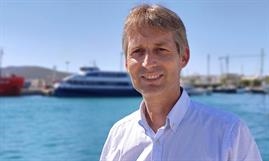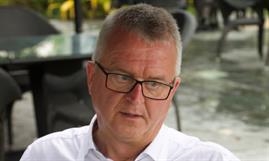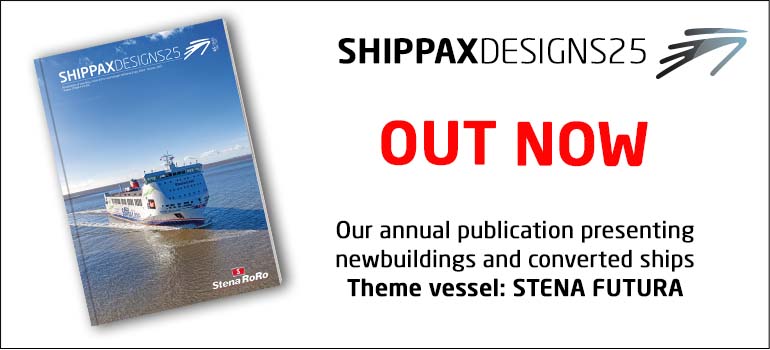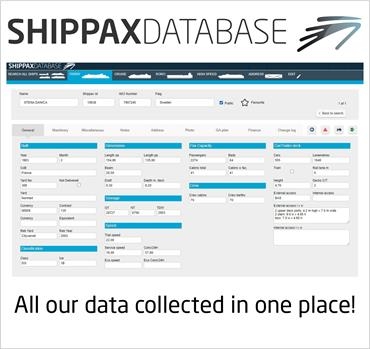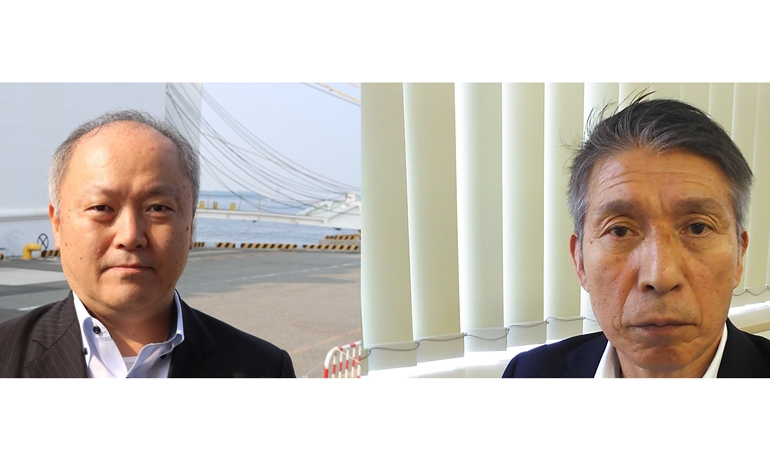
Nobuo Tsuboi and Yukio Abe
IN CONVERSATION WITH FERRY SUNFLOWER AND TAIHEIYO FERRY
InterviewFerry Sunflower, part of the MOL Group, is the most iconic Japanese ferry operator with its legendary red and orange sunflower logo that captures the spirit of the rising sun; perhaps one of the very few local companies known outside of the country itself. Taiheiyo Ferry is equally well-known within Japan, renowned for its genuine cruise ferry service and standards. Both companies have introduced major new ships in 2018/2019, changing the profile of their fleets as they invest for the future. Shippax had the opportunity to meet with leaders from both companies and discuss their operations, new vessels and views on the industry overall.
In discussion with:
Mr Nobuo Tsuboi, Director, Ferry Sunflower
Career history
1985: joined Mitsui O.S.K. Lines
2001: Representative of Mitsui O.S.K. Bulk Shipping (Asia, Oceania) Pte Ltd.
2006: Group Leader of MOL Car Carrier Division
2007: Vice President of Mitsui O.S.K. Bulk Shipping (USA) Inc.
2014: General Manager of MOL Nagoya branch
2018: Director of Ferry Sunflower Kobe
Mr Yukio Abe, Executive Director/General Manager Hokkaido, Taiheiyo Ferry
Career history
March 1973: joined Taiheiyo Enkai Ferry Co. (the predecessor of Taiheiyo Ferry)
March 2010: Logistics Manager
June 2011: Director/Logistics Manager
July 2013: Director/General Manager of Hokkaido Branch
June 2016: Executive Director/General Manager of Hokkaido Branch
Shippax: Please could you give a brief history of your company and explain your current operations?
Nobuo Tsuboi-san (NT):Ferry Sunflower is a subsidiary of the MOL Group, which owns 99% of the company. The business in its current form was created through the merger of MOL’s different ferry interests on the Inland Sea. This process started in 2007 with the incorporation of Blue Highway Line West into Diamond Ferry and was completed in 2009 when Diamond Ferry and Kansai Kisen were merged. We currently operate three routes across the Inland Sea, which previously belonged to those constituent companies. In 2013 we divested the former Kansai Kisen Matsuyama-Kokura route to local interests. To complete the story, Blue Highway Line East operating to Hokkaido became our sister company, MOL Ferry Co., Ltd.
Yukio Abe (YA): Taiheiyo Ferry was originally established in 1970 as Taiheiyo Enkai Ferry. We operate a regular route connecting approximately 1,330km from Tomakomai-Sendai-Nagoya with three of the largest car ferries in Japan. We play an important role as a public transportation system that transports customers, their vehicles and cargo vehicles loaded with various goods, safely, reliably and comfortably. We aim to continue to support the regional economy as a leader of the distribution and logistics of Hokkaido, Tohoku, and Chubu areas, and aim to be a company that can contribute to exchange and development, including Kanto and Kansai.
Shippax: Please could you give an overview of your current traffic and volumes?
NT: In total, we carry approximately 450,000 passengers annually and ship about 85,000 cars and 190,000 trucks or chassis/drops. Freight is the foundation of the business.
YA: In 2018, approximately 220,000 passengers and 105,000 trucks were transported. For the passenger sector, there are many people travelling by car to Hokkaido, especially in summer.
Shippax: Mr Tsuboi-san, what are the differences between Ferry Sunflower’s three routes on the Inland Sea? In particular, why are there two parallel routes from Osaka to Beppu and Kobe to Oita?
NT: The background of the individual routes lies with the history of our company, when our constituent companies were in competition. Osaka to Beppu was operated by Kansai Kisen while Diamond Ferry ran Kobe to Oita and Blue Highway Line ran Osaka to Shibushi. Today, we believe one of our competitive advantages is to offer three different connections across the Inland Sea, with the opportunity for customers to mix outward and inward routes and greater total capacity allowing freight customers to still travel with us if one departure is full. The profile of the routes is slightly different. Passenger numbers are highest on the Osaka to Beppu service, while freight is the main traffic for Kobe to Oita and Osaka to Shibushi.
Shippax: And Mr Abe-san, what are the differences between Taiheiyo Ferry’s two routes (Tomakomai to Sendai and Nagoya)? What percentage of your traffic travels to/from Nagoya? Is there a difference in the traffic and categories between the two routes?
YA: One of our ships, the new KITAKAMI, only travels back and forth between Tomakomai and Sendai, while our other two ships traffic the full route to Nagoya via Sendai (ISHIKARI, KISO), departing on alternate days. In this way, we can offer daily departures in both directions between Tomakomai and Sendai. About 35% of passengers travel from Tomakomai to Nagoya, while the figure for freight is around around 40%.
Shippax: What are the typical freight cargoes your companies carry?
NT: To Kyushu, general cargo, beverages and empty chassis are carried while eastbound to Honshu we carry vegetables, meat, and manufactured goods from the industrial centres in Kyushu such as automobile parts and tyres.
YA: From Tomakomai, Hokkaido, we principally carry agricultural products and livestock products. Many crops are transported south in autumn, the harvest season of Hokkaido. Food is shipped from Sendai to Tomakomai while machinery and new import cars will often be carried from Nagoya to Tomakomai.
Shippax: Are there seasonal variances in your traffic?
NT: Freight traffic is consistent year-round. Passenger traffic is focused on weekends and our key holiday periods such as New Year, Golden Week (from the end April to early May), and Obon Week (mid-August).
Shippax: Mr Tsuboi-san, how is the Inland Sea market performing in general? How are your three routes performing?
NT: Our two routes from Osaka are stable. With the introduction of our new ferries, passenger volumes to Shibushi have increased dramatically in the range of 16% compared to the previous year. Traffic between Kobe and Oita is currently declining.
Shippax: Mr Abe-san, how is the Hokkaido market performing in general? How has your business been performing in the last three years?
YA: The majority of the passenger traffic to Hokkaido is made up of tourists, and the number of both international and domestic flights is increasing and the number of foreigners is steadily increasing. The number of customers using Taiheiyo Ferry is increasing, but at a lower rate than the overall tourist market in Hokkaido.
Shippax: What are the specific competitive advantages your companies offer their customers?
NT: For passengers, Ferry Sunflower offers a range of products and promotions, for example the ‘Shu-Yu’ plan, which allows passengers to use different routes for their outward and return voyages, enabling visitors to Kyushu to travel around by car, bike or public transport. We have registered the trademark ‘Dangan Ferry’ (‘dangan’ means bullet) which is a plan, with a cheaper price, which allows passengers to disembark and embark the ferry on the same day and enjoy visiting the immediate area for 8-10 hours. It is popular with younger generations. A few times each year, we offer short daytime cruises on the Inland Sea during layovers, to encourage people to try our ferries. Lastly, we have introduced the new ‘casual cruise’ concept with the new Shibushi ferries, which aims to provide the bigger public spaces, plenty of private rooms and to enable passengers to enjoy an unexpected, comfortable time on board.
YA: Taiheiyo Ferry offers our customers a safe, reliable and comfortable service. In particular, since the Great East Japan Earthquake, we have also been focusing on fulfilling our social mission in maritime transport, such as transporting reconstruction-related cargo to the Tohoku region.
Shippax: What proportion of your passengers are Japanese compared to international? How is the recently introduced Japan Ferry Pass working for you?
NT: The vast majority of our passengers are still domestic. Domestic demand is very strong, but we will never stop encouraging international customers. The Japan Ferry Pass is still in its early days, but we expect demand to increase gradually, year by year.
YA: There are a certain number of international group passengers on board every month, but most of our passengers are Japanese customers. Since, at present, there is little use of Japan Ferry Pass, we remain very keen to attract international customers.
Shippax: What trends do you observe in the Japanese ferry market overall?
NT: As modal shift and the shortage of truck drivers continues to escalate, we see increased demand for using ferries for freight transport. The expectation of many workers, who previously may have once become truck drivers, is now to be at home every night and we do not expect this trend to change. Our population in Japan continues to age, and many have disposable time and money to spend, so this represents a great opportunity for the ferry market.
YA: Yes, in logistics, modal shift is happening more and more due to working our limits and environmental issues. Recently, as a response to the shortage of truck drivers, semi-trailers are focusing on unmanned navigation systems. In the passenger sector, Japan has experienced a cruise ship boom recently. Customers are increasingly aware of leisure opportunities by ship, but with this comes high expectations.
Shippax: What proportion of your passenger and freight bookings are made online or via mobile devices?
NT: For passengers, about 40% online and 60% by phone. We do not currently offer booking by mobile App. For freight, it is still 100% by phone and fax. Next year, however, we will introduce a new web booking system for our freight customers.
YA: Freight reservations are only available by telephone. About 70% of passengers are reserved from the Internet. We do not have a dedicated mobile App, but of course, you can access our website from your smartphone and make a web reservation.
Shippax: How do you use social media to attract passengers?
NT: Ferry Sunflower is present on Facebook, Instagram, and Twitter. Twitter just started from this April.
YA: We use social media as a means to share information. We are active on Facebook, Twitter, and Instagram.
Shippax: Mr Tsuboi-san, what were the key objectives with Ferry Sunflower’s new Osaka to Shibushi ships? What was the background to this order?
NT: Our objective was to collaborate with local authorities to encourage further local tourism in the Kagoshima province. The development of the Shibushi area itself has been slow until now, but there is much room to expand this and encourage new visitors to the area. With our ‘casual cruise’ concept we believe we can change perceptions of ferry travel and so generate more demand.
Shippax: And Mr Abe-san, what were the key objectives with your new KITAKAMI? What was the background to this order and what drove the timing?
YA: The previous KITAKAMI was commissioned in 1989. It was ageing, and it did not meet barrier-free requirements, which is important not just because of government legislation but because the majority of our customers are retired.
Shippax: What are the main differences between KITAKAMI and the rest of your fleet?
YA: Unlike the luxury facilities of the ISHIKARI and KISO, KITAKAMI is a new style of ship specialized in Sendai-Tomakomai. The second class shared dormitories (economy room) were abolished entirely and the number of private rooms was greatly increased. For the first time, we also included cabins where passengers can stay with pets. I think that it is appreciated by customers as a ship that responds to various needs in consideration of privacy.
Shippax: How was the ‘space’ theme chosen?
YA: The Sendai to Tomakomai service is an overnight crossing, when passengers often board at dusk, and we wanted to create the impression of travelling through the starry sky in space.
Shippax: What are the key technical innovations on your new vessels?
NT: The biggest innovation is the installation of the contra-rotating propeller.
YA: On the new KITAKAMI, fuel efficiency is improved both by the introduction of a navigation support system that responds to changes in weather and sea conditions to formulate an optimal voyage plan and an energy-saving hull form, which reduces the resistance of the hull and improves the propulsion efficiency by changing the method of supporting the propeller shaft and improving the shape of the hull.
Shippax: How do you view LNG and other more environmentally friendly fuel types? Were they considered for the SUNFLOWER SATSUMA or the KITAKAMI?
NT: We considered it as one option, but clearly did not proceed. There are still many items to be solved in this area, which hopefully will be clarified in the future.
YA: At the time of construction of the new KITAKAMI we did not consider this. From now on, it will be necessary to study new fuels such as LNG, triggered by the new sulphur regulation.
Shippax: Indeed, how will you manage the new SOx regulations for the remainder of your fleet? Will you install scrubbers or is there another solution?
YA: As with the KITAKAMI, we will use compliant fuel oil with a sulphur content of 0.5% or less. We have considered the installation of scrubbers, but have made the decision not to progress with this option at present.
NT: This is the same position for us at Ferry Sunflower, although our parent company is investing significantly in this area, innovating with LNG propulsion for example.
Shippax: Do you have any further plans for fleet renewal at present?
NT: Yes, we are looking to replace the Osaka-Beppu ferries, the 1998/9-built SUNFLOWER IVORY and SUNFLOWER COBALT in 2022 or 2023. It is rumoured that one of our competitors, Miyazaki Car Ferry, will order new ships shortly, with financial support from the local province.
YA: This is not yet decided; we will continue to evaluate the market and the KITAKAMI’s performance.
Shippax: What challenges and opportunities do you see for the future?
NT: In addition to continuing with our ‘casual cruise’ concept and generating more leisure and tourism passengers, it was announced in November 2018 that the universal World Expo 2025 will be hosted in Osaka city under the theme of ‘Designing Future Society for our Lives’. The location of the expo will be Yumeshima island, next to our ferry terminal, and we believe this will present the chance to attract many more visitors to Osaka by using our routes.
YA: I think the modal shift will go further due to the lack of human resources. In addition, since it is anticipated that the needs of elderly passengers will increase, we have to go further in our journey to become a company chosen to meet the needs of our customers. Internally, we think that it will be necessary to further develop and promote IT solutions to solve the shortage of labour which will only intensify in the future and which may otherwise impact our customer service.
Shippax: Gentlemen, thank you very much for your time and insights!
© Shippax / Richard Seville
sep 01 2019
Most read
Carnival Corporation full-year results
dec 21 2025
Not a Merry Christmas for CMAL and CalMac as two newbuilding ferries – GLEN ROSA and ISLE OF ISLAY - are further delayed
dec 22 2025
Christmas lunch rush at Öresundslinjens ferries
dec 19 2025


